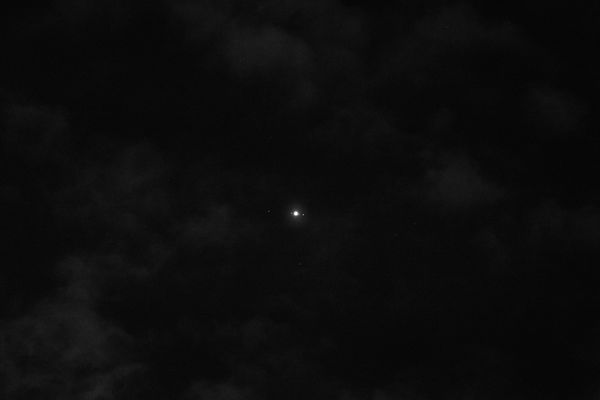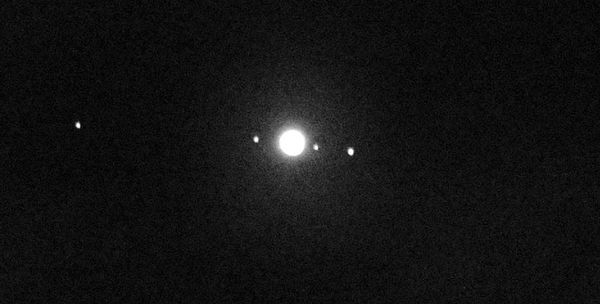Jupiter
Jul 6, 2020 07:59:04 #
Jupiter and Galilean moons shot with a Nikon D810 with a Tamron 150-600 mm
Jul 6, 2020 08:07:03 #
saside wrote:
Jupiter and Galilean moons shot with a Nikon D810 with a Tamron 150-600 mm
How can you I.D. these distant planets with any regular Digital Camera, even if it is a higher end camera. To this observer, they would just be considered as Stars in the Sky??? You must be an Astronomer professionally.
Jul 6, 2020 08:12:11 #
Jul 6, 2020 08:26:26 #
There are many ways to know what you are looking at. On my free US gov't. phone. I use an app called sky map it will show you every planet in the sky 24/7 and many other objects. As a side note I have an associates degree in Bus. Adm.
Jul 6, 2020 08:27:15 #
Jul 6, 2020 08:40:01 #
Good photo. You can distinguish the stars of other celestial bodies like the ancient greeks did, looking at them and if they are blinking they are stars if not they are another thing like planet or satelites.
Jul 6, 2020 09:30:04 #
Paul Diamond
Loc: Atlanta, GA, USA
Look into the sky. Mercury, Venus, Mars, Jupiter and Saturn are brighter than the other stars. One of the early names for the planets was "the wanderers" because the stars were fixed in place in the sky. But the wanderers would move day-to-day, month-to-month. You can look with your night adapted eyes, better with binocs and even better with a relatively cheap 'starter' telescope.
For the pics of Jupiter, try faster shutter speeds. You will lose the images for the moons to get proper exposure to show the possible color or banding of Jupiter. Or stack one image of the moons on top of a shorter duration picture of the disc of Jupiter.
For the pics of Jupiter, try faster shutter speeds. You will lose the images for the moons to get proper exposure to show the possible color or banding of Jupiter. Or stack one image of the moons on top of a shorter duration picture of the disc of Jupiter.
Jul 6, 2020 09:53:47 #
Thank you Paul, I used monochromatic setting to photo the moon too that night I set the camera on "program" which it chooses the "best" settings. Which we all know isn't but I did it cause I didn't want to spend to much time with it. the iso was on auto it hit 12800, shutter speed was 1/20 of a sec. I got the lens 2 days ago and will learn how to use it better with help of people like you.
Jul 7, 2020 07:38:49 #
Nice work on the astronomy side.
Free gov/t phone??? That phone wasn't free. It's just that someone other than you paid for it.
--Bob
Free gov/t phone??? That phone wasn't free. It's just that someone other than you paid for it.
--Bob
saside wrote:
There are many ways to know what you are looking at. On my free US gov't. phone. I use an app called sky map it will show you every planet in the sky 24/7 and many other objects. As a side note I have an associates degree in Bus. Adm.
Jul 7, 2020 07:39:51 #
John Sh
Loc: Toronto, Australia
saside wrote:
the iso was on auto it hit 12800, shutter speed was 1/20 of a sec.
As a rule of thumb for moon shots, ISO 100 - 200 max. F/8 and 1/250 sec shutter speed. The moon is a very bright, light emitting object and does not require extreme settings for a good capture. You should be able to auto focus but if not set your focus ring to the centre of the infinity mark.
Jul 7, 2020 08:21:22 #
Paul Diamond
Loc: Atlanta, GA, USA
saside wrote:
Thank you Paul, I used monochromatic setting to photo the moon too that night I set the camera on "program" which it chooses the "best" settings. Which we all know isn't but I did it cause I didn't want to spend to much time with it. the iso was on auto it hit 12800, shutter speed was 1/20 of a sec. I got the lens 2 days ago and will learn how to use it better with help of people like you.
Nothing about our digital cameras is truly set up for astrophotography. Your sensor always tries to create an 18% grey. (Let's not get into the picking of nits - working concept not theoretical physics.) To use your camera for pictures of astro objects, your sensor might work for the moon, if it is a substantial or full image in the field of view/sensor.
This is not critical or a critique, but an offer of helpful suggestions - Suggest you must go to manual settings. Even your moons of Jupiter were a bit blurred. Use a faster shutter speed (same wide open f/ stop, fixed ISO) and see if it reduces or eliminates the blur. Next look at your tripod (everything tightened down and no leg sections or center column extended to the extreme, tripod head locked down tight) - is it doing it's job? Or do you need something more stable? With the lens zoomed out fully, if you 'tap' the camera, does the image in the viewfinder (daytime or night) move? vibrate?
Next look to the camera itself. Does the shutter/mirror mechanism of the camera cause camera motion/vibration/blurring? Try mirror up. Try self timer of 2-5-10 seconds.
Don't let this scare you away. Getting the best of your camera, your lens, your tripod will help you in other areas of your picture taking. Look for the 'weaknesses' that you can work around to produce something better. Focusing your lens at infinity may or may not be 'easy' when it is the night sky and a star or planet. Do you need to adjust your viewfinder diopter settings for the sharpest focusing? And, most important - keep trying. Learn from your experiments.
Jul 7, 2020 08:47:50 #
saside wrote:
Jupiter and Galilean moons shot with a Nikon D810 with a Tamron 150-600 mm

 Jupiter has been low in the evening sky and has been really bright the last few days....great shot.
Jupiter has been low in the evening sky and has been really bright the last few days....great shot.Jul 7, 2020 12:43:16 #
rmalarz wrote:
Nice work on the astronomy side.
Free gov/t phone??? That phone wasn't free. It's just that someone other than you paid for it.
--Bob
Free gov/t phone??? That phone wasn't free. It's just that someone other than you paid for it.
--Bob
So all the taxes I paid to the federal gov't doesn't count?
Jul 7, 2020 12:45:50 #
Jul 7, 2020 14:59:34 #
Sa, most people are talking about the exposure of Jupiter and the Jovian moons. Perhaps a shorter shutter speed would bring out the details on the planet's surface clouds. However, you will lose the moons in the shot. So what you do is shoot it twice; slow speed for the moons, and fast speed for planet detail. Who know, it may work out for you, just a little post-processing to get everything in alignment. RFB
If you want to reply, then register here. Registration is free and your account is created instantly, so you can post right away.






